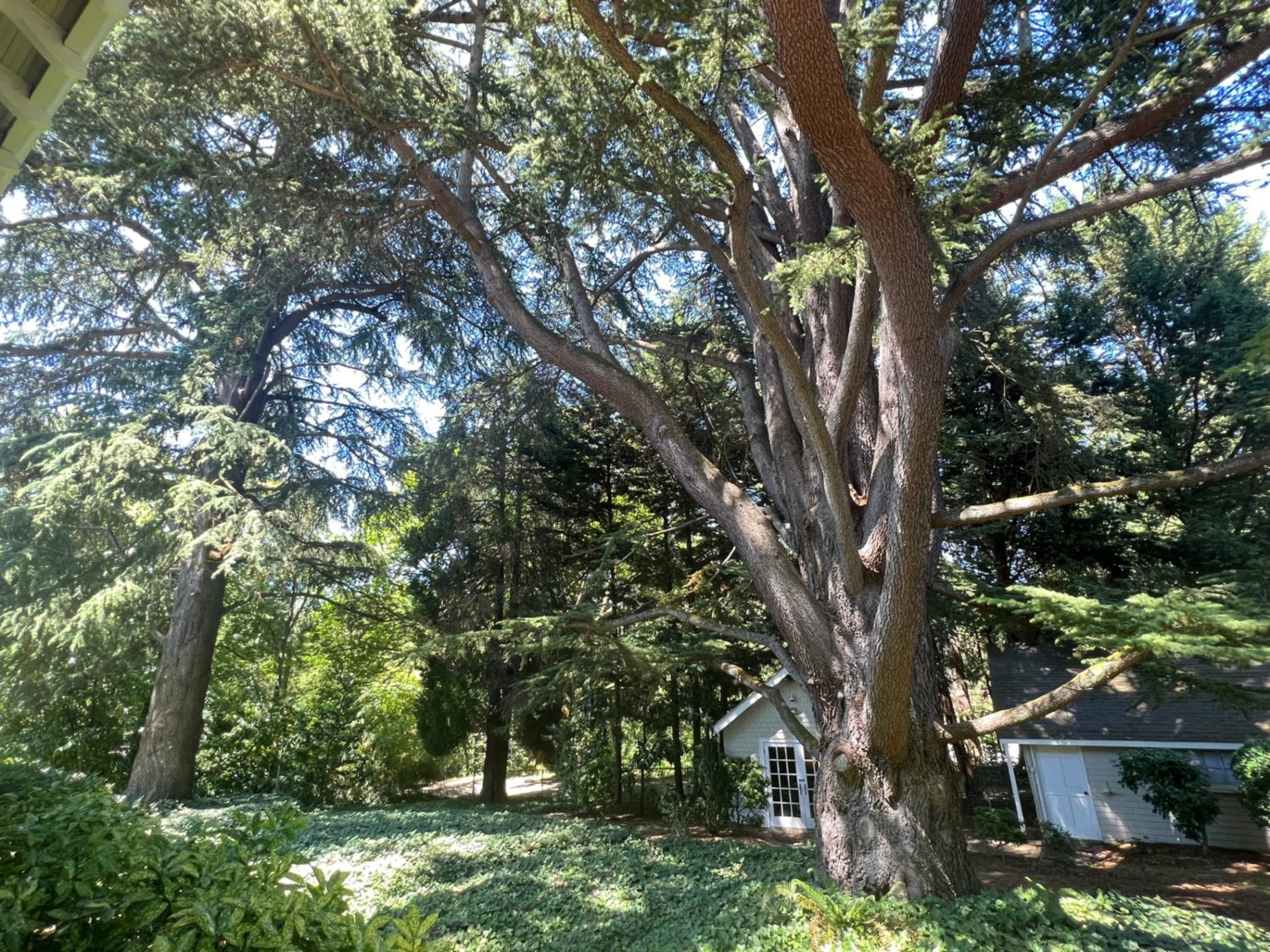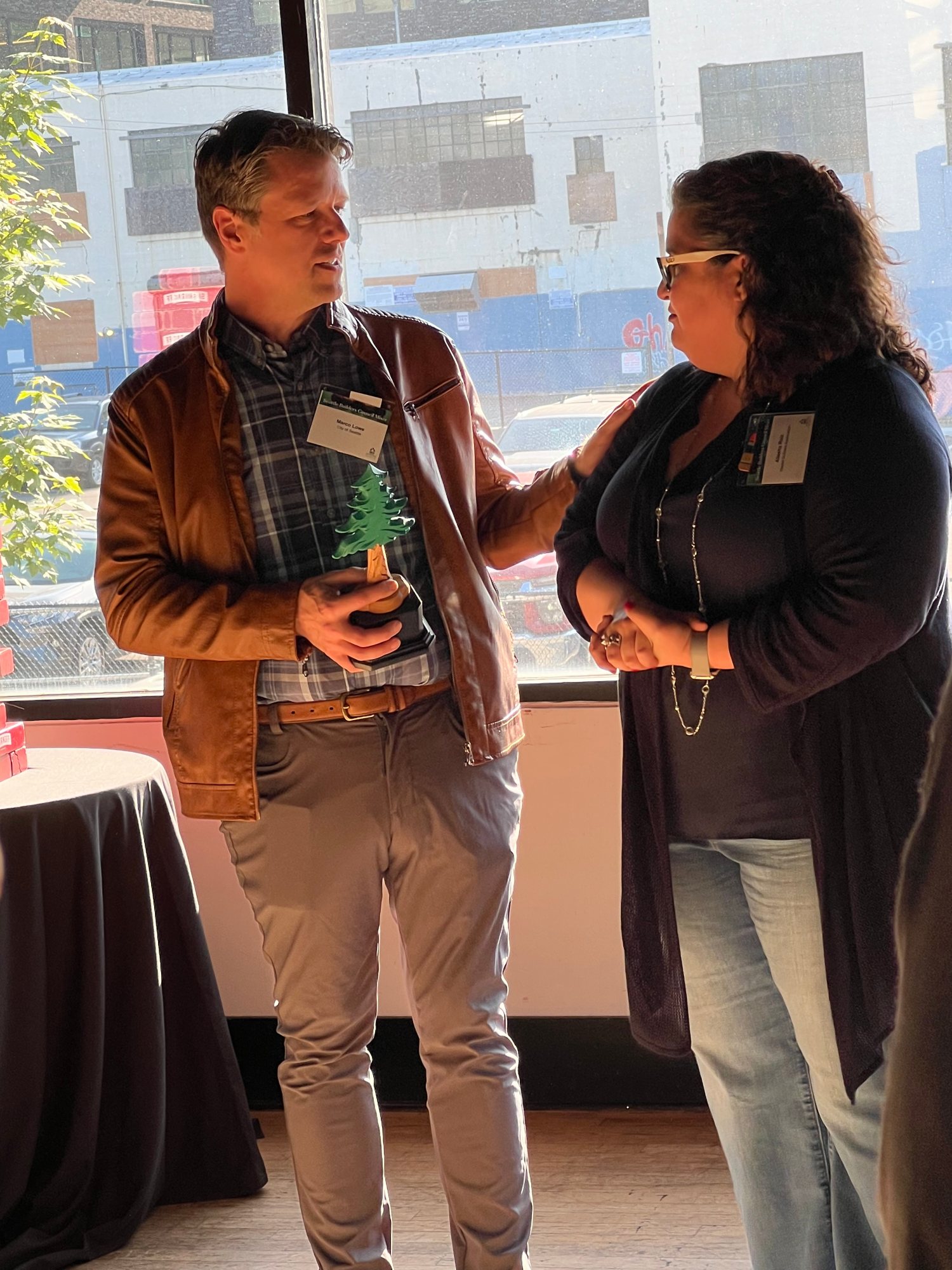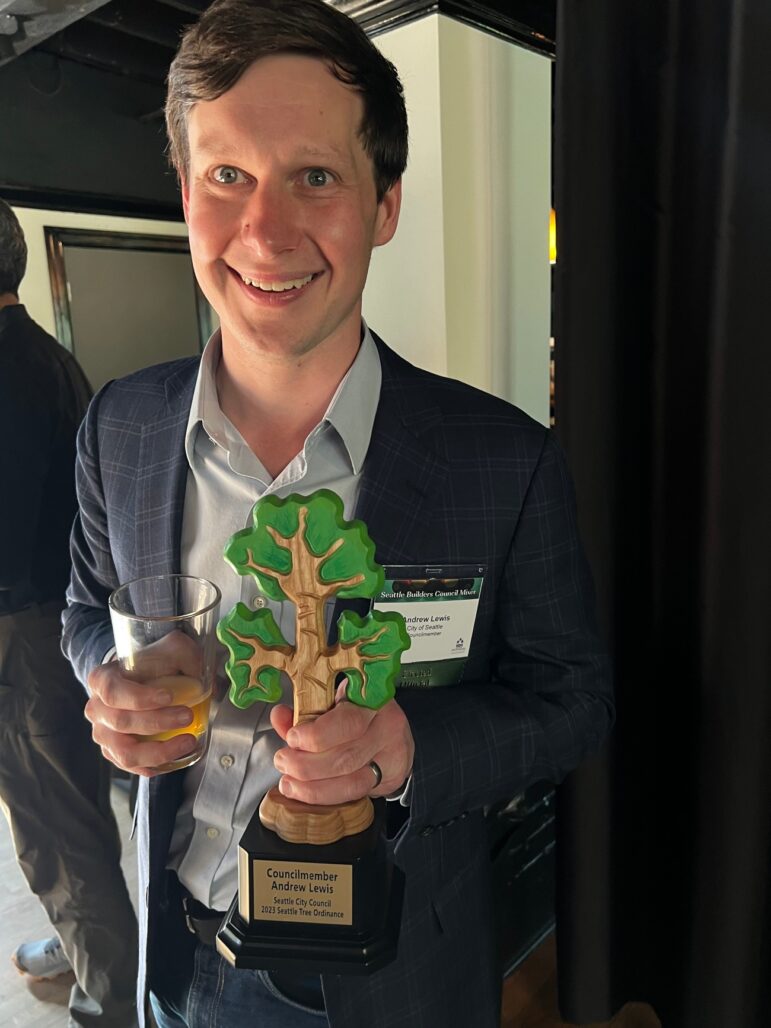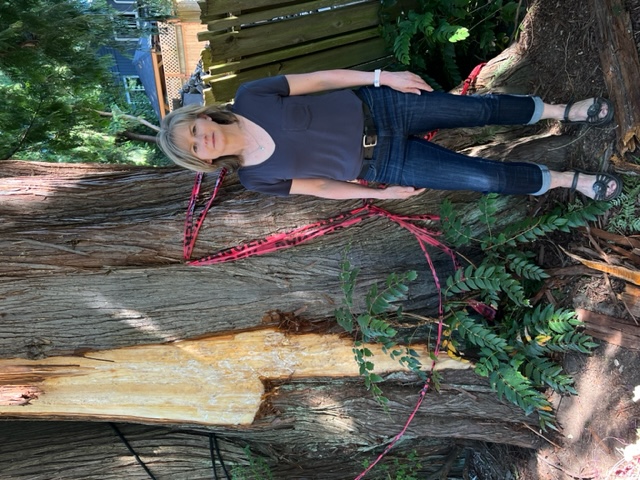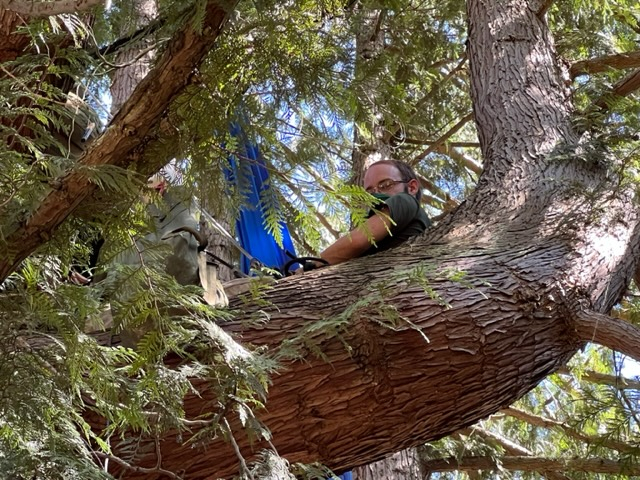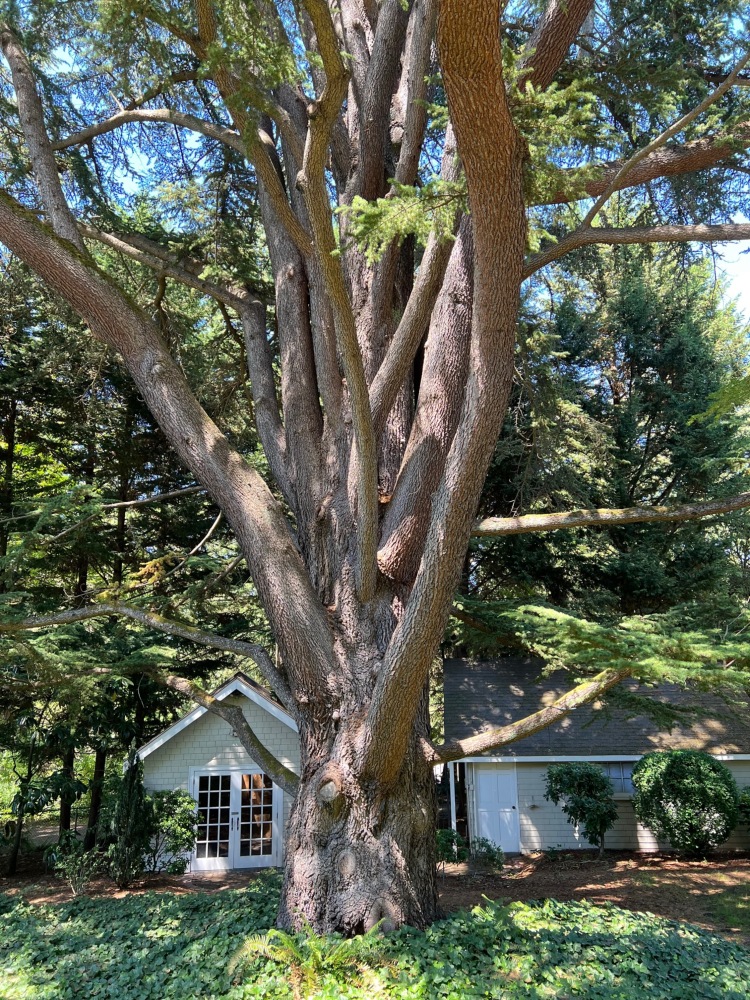Urban tree advocates question builders’ behind-the-scenes role
By Eric Scigliano / InvestigateWest
On June 1, the mood was exuberant at Art Marble 21, a sunlit Seattle bar and meeting space. The event was the annual “mixer” of the Seattle Builders Council, a division of the Master Builders Association of King and Snohomish Counties (MBAKS), “the nation’s oldest and largest local homebuilders association.” But the occasion was not just social.
Nine days earlier, in a 6-1 vote, the City Council had passed a long-sought, hard-fought tree protection ordinance opposed by many tree-protection advocates, neighborhood groups and the city’s own Heritage Tree Committee. Some opponents denounced it as a “corrupt” giveaway to developers and a death knell for Seattle’s declining urban forest. The city’s Urban Forestry Commission, an expert panel charged with advising on tree policy and regulations, unsuccessfully pleaded to delay the vote a month so it could study the ordinance it complained it hadn’t been given time to review.
The forestry commissioners didn’t make the mixer’s invitation list, which included not just builders but Seattle City Council members and staff and officials from the Mayor’s Office, City Attorneys’ Office, Department of Construction and Inspections (SDCI), and other city agencies. A sign reading “Elected Officials Reception” pointed the way upstairs.
There, 50 or so guests schmoozed and grazed the buffet table until Master Builders staffers herded them into an adjacent room, where about 20 tree-shaped wooden trophies lined a long table. Each bore a small plaque honoring someone who had helped pass the ordinance.
Aliesha Ruiz, the association’s government affairs manager, dispensed the awards with effusive expressions of affection for colleagues and city officials alike, especially for someone who’d been both: Marco Lowe, the city’s chief operating officer and Mayor Bruce Harrell’s point man on housing and land use, who had last held Ruiz’s job at the Master Builders.
“It’s been a long, long effort to get this legislation passed,” Ruiz declared. “We don’t love it—”
“Yes, we do!” a voice called out.
“We didn’t get everything we wanted,” Ruiz continued, “but it strikes a balance for housing and for trees.” She turned to the tree trophies: “These come all the way from Romania!”
“No Seattle trees were killed,” quipped Lowe, to loud laughter.
Ruiz bestowed trophies on the Master Builders officers and attorneys and city bureaucrats who’d helped shape the ordinance. She especially lauded the Seattle Builders Council’s vice chairman: “For those of you who don’t know, the 85 percent capacity test was Michael Pollard’s brainchild!” This key provision, which one veteran environmental lawyer calls “the single most damaging change to the original draft ordinance,” guarantees builders in low-rise multifamily zones (allowing townhouses and small apartments) the right to cover 85 percent of their lots with buildings and other hardscape, regardless of what trees grow there.
“Don’t you have to cut down a forest to win one of these?” someone called from the crowd, to more laughter.
Ruiz continued: “We especially want to honor the elected officials who had the courage to stand up to pressure and see this through.” Andrew Lewis was the only one of the six City Council members who voted for the ordinance to attend. Councilmember Dan Strauss, who chairs the council’s land use committee and pushed the ordinance through, sent an aide, as did two other councilmembers.
News of the party quickly spread among Seattle’s tree advocates, who’d struggled for a decade or more to make the city enforce its loophole-ridden interim tree code, crack down on a “Wild West” of illegal cutting, and pass a stronger tree ordinance. Though Ruiz, echoed by an SDCI spokesperson, insisted it was merely an annual mixer, “not a special event” or “celebration of the tree code,” it seemed to confirm the tree huggers’ darkest suspicions about the process that produced that code.
Stuart Niven, an arborist and outspoken Urban Forestry commissioner, puts it starkly: The event “clearly shows the brazen arrogance of MBAKS and their reach and control over City Hall.” The result of the ordinance, he warned the City Council on the eve of its passage, would be “a culling of the urban canopy and associated habitat, benefiting only the bank accounts of developers, real estate investment entities” and their lobbyists.
Not everyone’s assessment is so grim. “The ordinance is not ideal, but it’s better than what we have now,” says Steve Zemke, the chair of Seattle’s TreePAC and founder of the Friends of Seattle’s Urban Forest, who as a past Urban Forestry commissioner worked for years on proposed tree protections. “Half of what we wanted is in there” — notably stiff in-lieu fees developers must pay when they opt not to replace trees they remove, and replacement-or-fee requirements for trees with trunks as small as 12 inches thick. Still he worries about the influence development interests exert on those who draft and enforce city codes: “The city people work with them night and day. Developers are paying their salaries [via permit fees], 90 percent. They’re not funded by the taxpayers.”
Lowe, the city’s chief operating officer and former Master Builders staffer, sees cooperation as something to be embraced, not feared. “The Master Builders have been trying to have a less contentious relationship with the city. I really tried to bring a collaborative voice there.”
Benign as “tree protection” sounds, it’s one of the most contentious, emotionally charged, and technically complex issues that cities face, lying at the confluence of housing and health, building density and wild habitat, local livability and global climate. Three mayors had avoided wading into the issue before the newly installed Harrell, in February 2022, introduced a tree ordinance drafted by SDCI under his predecessor, Jenny Durkan.
The Master Builders, however, sued to block the draft ordinance, claiming it would make development “expensive, uncertain and problematic” and have “severe impacts on housing and other elements of the environment.” In August 2022, the city’s hearing examiner rejected their appeal, finding that the Master Builders hadn’t shown that saving trees would drive up housing costs.
The Master Builders meanwhile set out to join and sway the effort rather than fight it. They offered their own proposal, trumpeting several feel-good gestures: a “citywide tree fund” that would collect fees to remove large trees and “award them where possible to organizations that focus on BIPOC youth tree education,” and “strategic tree planting” to form “pollination pathways for birds, bees, and other insects.” But their proposal also included a sweeping provision to let builders and homeowners “remove any tree… for any reason” — as long as they got permits and paid into the tree fund.
“That letter made us all laugh,” says Sandy Shettler of TreePAC and Friends of Seattle’s Urban Forest. “We never thought that every single thing they asked for would be granted, along with many new things we didn’t even think of.”
After repelling the Master Builders’ suit, the Harrell administration took the tree ordinance back in-house for six months of intensive revision. Questions arose over the process and the substance of revision. The Urban Forestry commissioners received periodic updates from the Department of Construction and Inspections until December. In September, at the last of two meetings they had with Lowe and his team, two commissioners recall Lowe emphasizing that tree protection couldn’t stand in the way of housing. (Lowe doesn’t recall the meeting.) The commissioners didn’t see the completed draft until it was publicly released in March, and they complained in an April letter to the council and mayor that it “appears to have been developed behind closed doors without substantive participation by the Commission and other stakeholders” and without “adequate time… to reflect and make well-informed recommendations.”
Meanwhile, SDCI managers met monthly with the Master Builders, as SDCI media director Bryan Stevens says they have “for many years,” to “discuss pinch-points in the permitting process,” from “land use and tree reviews” to technical issues. “The MBAKS representatives typically set the agenda and the invitees,” Stevens explains. “If a code or policy change is coming, we often include a representative of the code development team.” Outside these monthlies, he says, SDCI and the Master Builders didn’t meet while the code was being revised.
The meetings nevertheless piqued tree activists’ fears that, as Shettler puts it, “the ordinance was rewritten by Helsell Fetterman,” the Master Builders’ land use attorney. In a heated letter to the council on the eve of the final vote, Niven called Strauss an “MBAKS honorary member” who was “duping” his colleagues into passing it.
“I turn a deaf ear to the Master Builders,” responds Strauss. “They sued us to try to block the ordinance!”
Despite Shettler’s alarm, the developers didn’t get everything they wanted. Master Builders representatives answered only one of 10 written questions InvestigateWest tendered at their request after they declined to participate in an interview: What parts of the ordinance do you dislike and hope to change? They replied that by lowering the trunk-diameter thresholds for larger trees subject to regulation, the ordinance will “limit housing opportunities.” They assailed its fee-in-lieu scheme, which lets developers pay to remove big trees without planting replacements. And they complained that a new requirement that developers plant curbside trees when they build in neighborhood residential (formerly “single-family”) zones will also raise housing costs.
But the Master Builders scored big wins on the new ordinance’s most important provisions — notably Michael Pollard’s “brainchild,” the guaranteed 85 percent lot coverage in low-rise multifamily zones, plus a 100 percent guarantee in mid-rise, commercial and multiuse zones, which the City Council added. These guarantees provide not only the “predictability” and “clarity” developers have long sought but, in many cases, more room to build.
They combine existing building-footprint allowances and requirements for parking, walkways, common amenities, and other features, “based on what the city is [already] requiring developers to provide,” Strauss explained when he moved to adopt the ordinance. But data provided by SDCI’s Stevens show that those requirements actually vary widely: as low as 65 percent of lot area in zones where builders will now be allowed to cover 85 percent in hardscape, and as low as 90 percent in zones where they’ll now be allowed 100.
If trees and their protection zones cut into those allowances, builders can cut them down and pay to have replacements planted elsewhere in the city (or, Strauss says hopefully, avoid fees by planting on roofs and pediments). Those who keep big trees earn big reductions in how much space they must consign to setbacks, walkways and amenities.
Builders can now remove even the biggest trees to get their allotted coverage, aside from about 320 landmark “heritage trees” designated under a prior voluntary program. Urban Forestry Commission co-chair Josh Morris warns that people shouldn’t “get the idea this provides protection for a significant number of trees.”
By contrast, owners who aren’t redeveloping their property come under much stricter regulation than before: They can’t cut trees thicker than 12 inches that aren’t hazardous, and they can only remove two 6- to 12-inch trees every three years. Before, developers would sometimes demand that homeowners, who faced less legal scrutiny, cut down trees before closing purchases. Now the only way for homeowners to get rid of unwanted trees may be to sell to developers.
The ordinance includes a stinger for neighbors and activists opposing tree removals, and a boon to developers who resent such interference: They’ll no longer be able to appeal to the hearing examiner. SDCI’s decisions will be final.
If these changes work as promised, the net effect will be not to raze Seattle’s tree canopy, as some tree and equity advocates warn, but to shift the burden of preserving it from developers to homeowners and City Hall. The oft-cited justification for this shift is the 2021 Tree Canopy Assessment produced by the city’s Office of Sustainability and Environment with data from the University of Vermont’s Spatial Analysis Laboratory. But this assessment and the ways it’s been characterized by the ordinance’s promoters rest on misapprehensions and incomplete and misleading data. Tree advocates wanted to “debunk” it, says Shettler, but the release of the draft ordinance a week later “swept that aside.”
For boosters, the takeaway from the assessment is that development doesn’t cause canopy loss, established homes and city parks do. Councilmembers and the construction department, sustainability office, and, of course, the Master Builders have all dismissed or diminished development’s role because only a small share, about 1 percent, of all Seattle’s acreage got redeveloped from 2016 to 2021. Instead they’ve emphasized, as SDCI’s Stevens puts it, that “most tree loss is occurring outside of redevelopment and in areas zoned Neighborhood Residential or park land.”
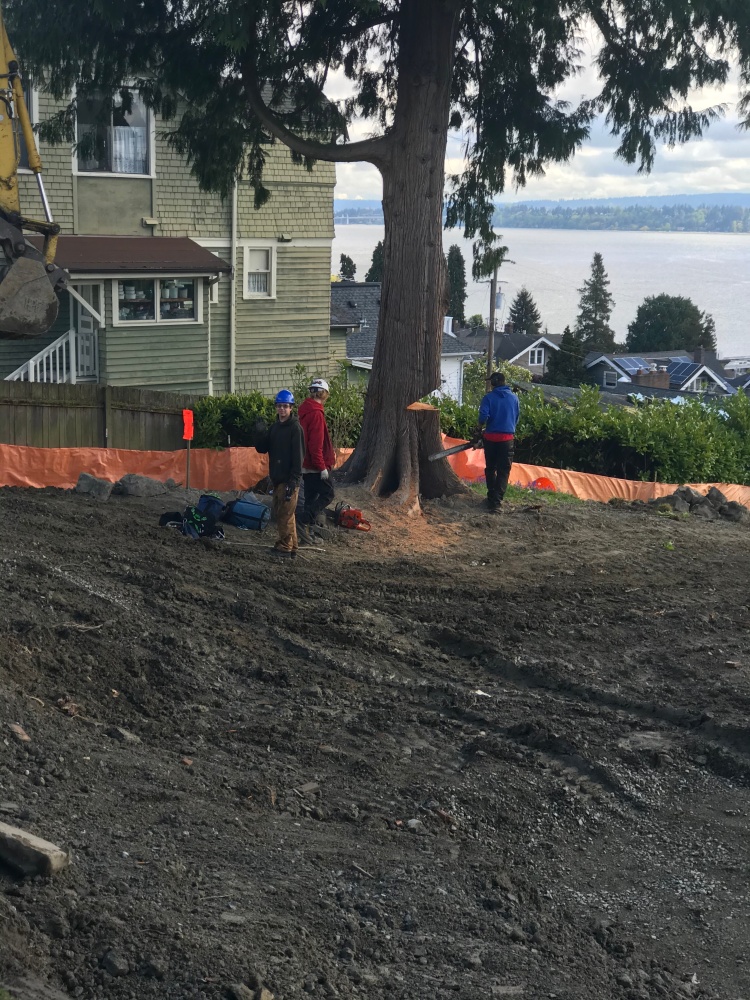
A large redcedar in Seattle’s Leschi neighborhood, illegally cut down in late 2022. Like many big trees, it stood at the property’s edge, outside the development footprint. According to a report in the Leschi News, an environmental consultant found it would take 57 newly planted trees to replace the stormwater retention it provided. The Seattle Department of Construction and Inspections required five. The new tree code would require one replacement sapling. (Jayn Foy photo)
In fact, neighborhood residential zones and parks sustained relatively low rates of loss, 1.2 and 2.5 percent respectively. But their losses loom large in absolute terms because so much of Seattle’s total canopy grows in them; nearly half in the neighborhood zones and one-fifth in parks.
Still, parcels that got redeveloped lost a much larger share of their canopy, nearly 40 percent — a significant share, about 14 percent, of all canopy lost in the city. And as Zemke notes, that’s a conspicuous undercount, because the canopy assessment counts as “redeveloped” only parcels where construction was started and completed during the five-year assessment period. That excludes all development that started earlier and finished then, or started then and finished later. That missing acreage was compounded by the pandemic, which dramatically slowed construction in 2020 and 2021.
By contrast, the canopy reported lost in parks was probably overstated — “a red herring,” as Zemke calls it — reflecting not only lost trees but invasive weeds that parks managers cleared in order to plant new trees. The Vermont lab measured canopy at 8 feet above the ground; as Zemke notes, other jurisdictions measure it at 12 feet or, in the case of the U.S. Army Corps of Engineers, 20 feet. Many shrubs grow above 8 feet and thus register as canopy, including unwanted English holly, cherry laurel and Himalayan blackberry. During the assessment period, the Parks Department cleared 2½ times as many acres of such overgrowth as all the net canopy loss the assessment identified.
Whether or not park canopy is as threatened as claimed, the new ordinance’s in-lieu fees will provide more funding for planting in parks and along streets, especially in undershaded, underprivileged neighborhoods. Its stringent limits on cutting by homeowners should indeed boost canopy on plots that don’t get redeveloped. And another tree-friendly provision makes developers ensure that the replacement trees they plant survive at least five years. But the short- to medium-term result of a code that favors prospective future trees over existing mature trees will be a patchwork of largely unshaded new construction and leafy older homes, curbsides, parks and greenbelts. And as veteran arborist Tina Cohen notes, deforestation is contagious: “Big trees protect each other by blocking prevailing winds and fusing their roots. Removing them from one lot may expose those on neighboring lots.”
Strauss still forecasts a bright future: “When these trees grow they will meet and exceed the canopy of the trees that will be removed, by growing in a place that is suitable, with the protections we have passed.” But even if that pans out, uneasy decades of mounting heat, wildfire smoke and drought loom in the interim. “You’re asking for it right now,” counters Strauss. “I’m doing this for my grandchildren, not my parents.”
The vision he and other boosters promote also treats tree canopy as fungible and transferable: cut here, replant there. But park trees won’t shade homes or lower air conditioning bills and energy footprints when the next heat dome descends. Canopy, like politics, is local. “We need trees where we live,” explains Jim Davis, co-founder of the Last 6000 campaign (dedicated to Seattle’s last “majestic” trees with trunks 30-plus inches thick). “That’s the heat island effect.”
Strauss and several other councilmembers promised to consider “cleanup” revisions before the ordinance takes effect next week, implicitly conceding that, with many novel, untested provisions, it may need more work. They haven’t gotten to any yet.
Alex Pedersen, the lone city councilmember to vote against the new ordinance, had a suggestion. Last year, with Strauss as a co-sponsor, he moved to create an “urban forester” position, a “super-arborist” who would oversee, perhaps even integrate, the disjointed actions of the nine city departments that deal with trees. On July 12, the city finally posted the position.
“We need the urban forester’s office to be put in the tree protection ordinance and filled as soon as possible,” says Pedersen, for better monitoring on the ground and better information for regulators and lawmakers alike. “We don’t want to continue to have those who profit from ripping out trees continue to dominate the process and agenda of tree protection.”
FEATURED IMAGE: A designated heritage tree, an Atlas cedar in Seattle’s Ravenna neighborhood. (Eric Scigliano/InvestigateWest)
InvestigateWest (invw.org) is an independent news nonprofit dedicated to investigative journalism in the Pacific Northwest. Visit invw.org/newsletters to sign up for weekly updates.
CORRECTION: This story has been updated to reflect the fact that the city of Seattle posted an opening for an urban forester last week.

